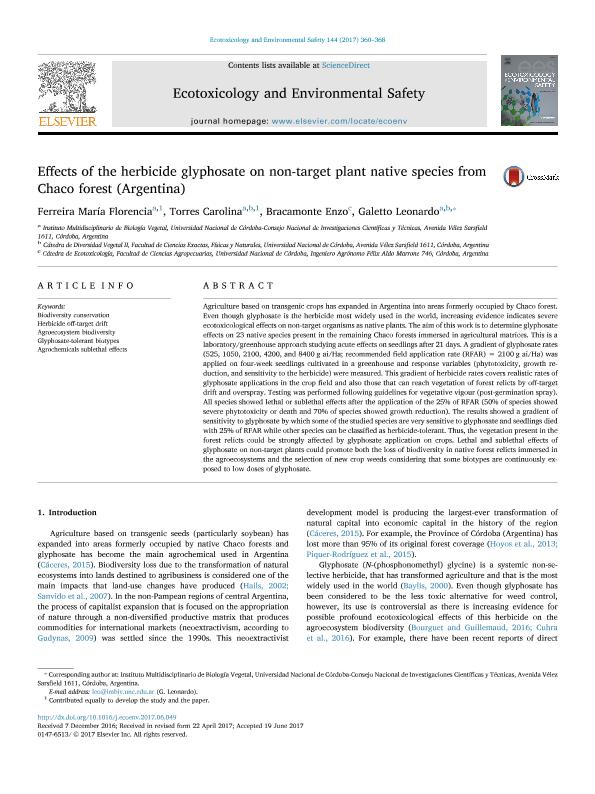Mostrar el registro sencillo del ítem
dc.contributor.author
Ferreira, María Florencia

dc.contributor.author
Torres, Carolina Cecilia

dc.contributor.author
Bracamonte, Enzo
dc.contributor.author
Galetto, Leonardo

dc.date.available
2018-01-18T17:31:30Z
dc.date.issued
2017-10
dc.identifier.citation
Ferreira, María Florencia; Torres, Carolina Cecilia; Bracamonte, Enzo; Galetto, Leonardo; Effects of the herbicide glyphosate on non-target plant native species from Chaco forest (Argentina); Academic Press Inc Elsevier Science; Ecotoxicology and Environmental Safety; 144; 10-2017; 360-368
dc.identifier.issn
0147-6513
dc.identifier.uri
http://hdl.handle.net/11336/33800
dc.description.abstract
Agriculture based on transgenic crops has expanded in Argentina into areas formerly occupied by Chaco forest. Even though glyphosate is the herbicide most widely used in the world, increasing evidence indicates severe ecotoxicological effects on non-target organisms as native plants. The aim of this work is to determine glyphosate effects on 23 native species present in the remaining Chaco forests immersed in agricultural matrices. This is a laboratory/greenhouse approach studying acute effects on seedlings after 21 days. A gradient of glyphosate rates (525, 1050, 2100, 4200, and 8400 g ai/Ha; recommended field application rate (RFAR) = 2100 g ai/Ha) was applied on four-week seedlings cultivated in a greenhouse and response variables (phytotoxicity, growth reduction, and sensitivity to the herbicide) were measured. This gradient of herbicide rates covers realistic rates of glyphosate applications in the crop field and also those that can reach vegetation of forest relicts by off-target drift and overspray. Testing was performed following guidelines for vegetative vigour (post-germination spray). All species showed lethal or sublethal effects after the application of the 25% of RFAR (50% of species showed severe phytotoxicity or death and 70% of species showed growth reduction). The results showed a gradient of sensitivity to glyphosate by which some of the studied species are very sensitive to glyphosate and seedlings died with 25% of RFAR while other species can be classified as herbicide-tolerant. Thus, the vegetation present in the forest relicts could be strongly affected by glyphosate application on crops. Lethal and sublethal effects of glyphosate on non-target plants could promote both the loss of biodiversity in native forest relicts immersed in the agroecosystems and the selection of new crop weeds considering that some biotypes are continuously exposed to low doses of glyphosate.
dc.format
application/pdf
dc.language.iso
eng
dc.publisher
Academic Press Inc Elsevier Science

dc.rights
info:eu-repo/semantics/openAccess
dc.rights.uri
https://creativecommons.org/licenses/by-nc-nd/2.5/ar/
dc.subject
Agrochemicals Sublethal Effects
dc.subject
Agroecosystem Biodiversity
dc.subject
Biodiversity Conservation
dc.subject
Glyphosate-Tolerant Biotypes
dc.subject
Herbicide Off-Target Drift
dc.subject.classification
Otras Ciencias Biológicas

dc.subject.classification
Ciencias Biológicas

dc.subject.classification
CIENCIAS NATURALES Y EXACTAS

dc.title
Effects of the herbicide glyphosate on non-target plant native species from Chaco forest (Argentina)
dc.type
info:eu-repo/semantics/article
dc.type
info:ar-repo/semantics/artículo
dc.type
info:eu-repo/semantics/publishedVersion
dc.date.updated
2018-01-12T19:28:46Z
dc.journal.volume
144
dc.journal.pagination
360-368
dc.journal.pais
Países Bajos

dc.journal.ciudad
Amsterdam
dc.description.fil
Fil: Ferreira, María Florencia. Consejo Nacional de Investigaciones Científicas y Técnicas. Centro Científico Tecnológico Conicet - Córdoba. Instituto Multidisciplinario de Biología Vegetal. Universidad Nacional de Córdoba. Facultad de Ciencias Exactas Físicas y Naturales. Instituto Multidisciplinario de Biología Vegetal; Argentina
dc.description.fil
Fil: Torres, Carolina Cecilia. Consejo Nacional de Investigaciones Científicas y Técnicas. Centro Científico Tecnológico Conicet - Córdoba. Instituto Multidisciplinario de Biología Vegetal. Universidad Nacional de Córdoba. Facultad de Ciencias Exactas Físicas y Naturales. Instituto Multidisciplinario de Biología Vegetal; Argentina
dc.description.fil
Fil: Bracamonte, Enzo. Universidad Nacional de Córdoba. Facultad de Ciencias Agropecuarias; Argentina
dc.description.fil
Fil: Galetto, Leonardo. Consejo Nacional de Investigaciones Científicas y Técnicas. Centro Científico Tecnológico Conicet - Córdoba. Instituto Multidisciplinario de Biología Vegetal. Universidad Nacional de Córdoba. Facultad de Ciencias Exactas Físicas y Naturales. Instituto Multidisciplinario de Biología Vegetal; Argentina
dc.journal.title
Ecotoxicology and Environmental Safety

dc.relation.alternativeid
info:eu-repo/semantics/altIdentifier/url/https://www.sciencedirect.com/science/article/pii/S0147651317303846
dc.relation.alternativeid
info:eu-repo/semantics/altIdentifier/doi/https://doi.org/10.1016/j.ecoenv.2017.06.049
Archivos asociados
